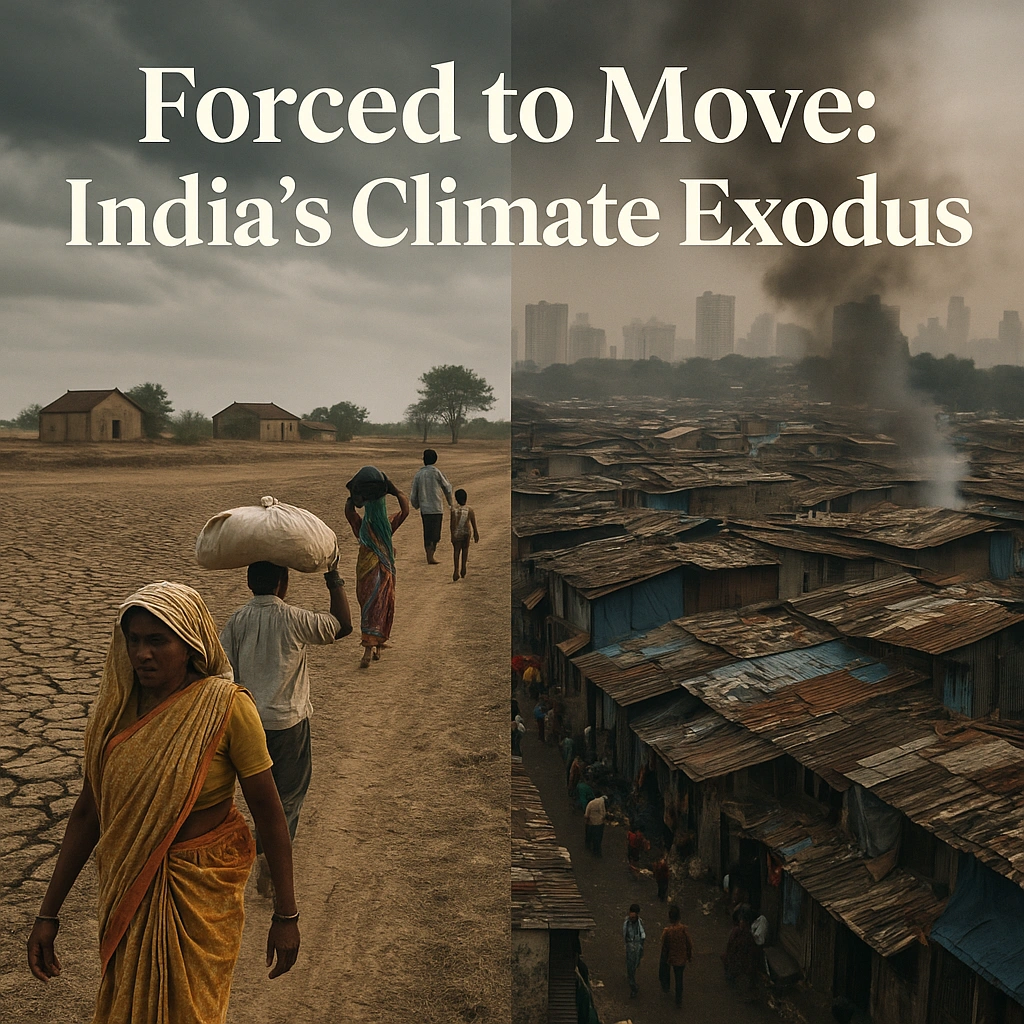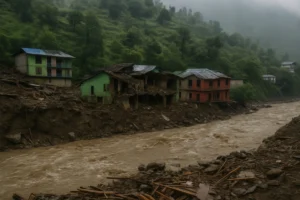“Nowhere to Go”: The Harsh Truth About Climate Migration in India

As India's climate crisis deepens, rural families are being pushed into overcrowded cities with no safety net.
It starts with the land. Not all at once—first the cracks show, then the water disappears. A good monsoon becomes a bad one. Two failed harvests later, people leave. They don’t want to, but staying isn’t survival anymore. This is what climate migration in India looks like. And it’s already happening in thousands of villages.
Ask anyone in the Sundarbans or Bundelkhand. They’ll tell you—climate isn’t just changing, it’s pushing people out of their homes. Silently, steadily.
But unlike the floods or droughts that displace them, these migrants go largely unnoticed. They’re not considered “refugees.” There’s no official label, no rehabilitation scheme. They just… leave.Recent studies reveal that climate migration in India is not just a future threat—it’s a present-day reality affecting millions. From coastal erosion in Odisha to failed crops in Maharashtra, the environmental triggers are clear. Yet, there’s still no official mechanism to track or support those affected by climate migration in India, making it one of the country’s most underreported humanitarian crises.
Table of Contents
“We Left Everything Behind”
Sabita Das, 42, used to own two bighas of land in West Bengal’s South 24 Parganas. The river claimed most of it. Salty soil ruined the rest. “We didn’t want to move,” she says. “But what would we eat?”
Her family moved to Kolkata four years ago. Now she works as a housemaid. Her husband drives a rickshaw. Her children dropped out of school. Nobody in the city knows she’s a climate migrant. Nobody helped them resettle.
Sabita’s story isn’t unique. From Odisha’s eroding coastline to the drought-stricken fields of Vidarbha, climate migration in India is growing—but remains ignored. There are no formal records, no national database, and worse, no serious public conversation.
An Unseen Human Crisis
According to a World Bank report, India could see over 45 million internal climate migrants by 2050. But here’s the catch: we don’t even have a legal term for them.
These are not refugees crossing borders. They are citizens forced out by environmental collapse—rising sea levels, heatwaves, vanishing water sources. And our laws don’t see them.
The Disaster Management Act talks about cyclones and earthquakes, but not the long-term loss of livelihoods due to slow disasters like drought or soil salinization. So when people migrate because their land can no longer sustain them, they get nothing—not compensation, not resettlement, not even acknowledgment.
It’s almost as if they vanish.
Cities Are Overwhelmed—but No One Connects the Dots
So where do people go?
Mostly to cities. Delhi. Mumbai. Hyderabad. Lucknow. They end up in slums and informal settlements, competing for jobs that barely exist, working long hours in unsafe conditions.
And here’s the irony—urban planners rarely talk about climate migration in India. You’ll hear terms like “rural push” or “economic migration.” But they almost never link it to the climate crisis.
And yet, countless urban poor in Indian metros are former farmers, fishermen, or cattle herders whose regions collapsed under extreme weather. We call it urbanisation. But it’s displacement. Plain and simple.
Ignored by Policy, Forgotten by Media
The silence is not accidental.
Recognising climate migration in India would mean accepting policy failure. It would require accountability. And it would force the government to plan long-term rehabilitation—not just distribute short-term relief after a flood or cyclone.
Right now, there’s no ministry that takes ownership of this issue. The Ministry of Environment deals with emissions and forests. The Ministry of Rural Development runs schemes like MGNREGA. But no one is mapping climate-exposed areas or tracking how many people are being forced to move.
It’s a blind spot in the system. And the cost is being paid by the poorest.
What This Migration Really Feels Like
You can measure climate change in Celsius or centimeters. But for those living through it, it’s much more personal.
It’s watching your well run dry.
It’s hearing your neighbors leave—first a few, then dozens.
It’s sending your daughter to the city to find work, not knowing if she’ll be safe.
It’s selling your only goat to buy train fare.
This is what climate migration in India feels like. It’s not a future scenario. It’s a present-day emergency, unfolding every day across the country.
Other Countries Are Doing More
Bangladesh, with far fewer resources than India, has already started relocating high-risk coastal communities. They’ve created early warning systems, mapped vulnerable zones, and invested in local adaptation.
Even Kenya has built resettlement models for pastoral communities affected by drought.
India, meanwhile, is still debating whether this is even “a real issue.”
You can also read Foods to Boost Immunity During Monsoon: A Rainy Season Diet That Actually Works
What Can Be Done—Before It’s Too Late
The answers aren’t complicated. What’s missing is urgency.
- Official recognition: We must legally define climate migration in India as a category of displacement.
- Mapping vulnerability: Identify hotspots—regions where environmental collapse is pushing people out.
- Urban planning: Cities need to prepare for incoming migrants—housing, healthcare, schooling.
- Welfare access: Migrants should retain access to ration cards, MGNREGA, and social services even after moving.
- Awareness: This story needs to be told. Loudly, repeatedly, truthfully.
Because if we keep pretending it’s not happening, the crisis will only grow larger, costlier, and more painful.
We Can’t Afford to Look Away
Climate migration in India is the country’s most urgent untold story. It’s already shaping demographics, destroying livelihoods, and reshaping rural and urban economies. But because it happens slowly, without drama or headlines, it gets ignored.
The next time you pass a slum in Delhi or Mumbai, look a little closer. Some of those families might be from flooded islands, or barren villages where the rain hasn’t come in years. Their story is our story too.
We still have time to act. But only if we first choose to see.
You can also go through Climate Migration 101: An Explainer




1 thought on ““Nowhere to Go”: The Harsh Truth About Climate Migration in India”